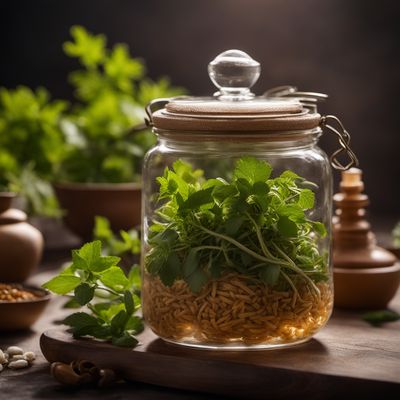
Ingredient
Other Herbal infusion materials from roots
Exploring the World of Herbal Infusions
Other herbal infusion materials from roots, like ginger, turmeric, or licorice, are known for their distinct flavors and potential health benefits. Ginger adds a warm, spicy kick to beverages and dishes, while turmeric offers a vibrant yellow color and earthy taste. Licorice root provides a sweet, herbal flavor. These ingredients can be used to make invigorating teas, infuse flavors into soups or stews, or add depth to sauces and marinades.
Origins and history
The use of herbal infusions dates back thousands of years and is deeply rooted in various cultures around the world. Ginger, for example, has been used in traditional Chinese and Ayurvedic medicine for its digestive and anti-inflammatory properties. Turmeric has a long history in Indian cuisine and is renowned for its vibrant color and potential health benefits. Licorice root has been used in traditional medicine and confectionery for centuries.
Nutritional information
Other herbal infusion materials from roots offer various health benefits depending on the specific ingredient. Ginger is known for its anti-inflammatory and digestive properties, while turmeric is prized for its potential antioxidant and anti-inflammatory effects. Licorice root may have soothing properties and is often used to relieve coughs and sore throats. These ingredients are low in calories and fat but can add depth and flavor to dishes and beverages.
Allergens
None
How to select
When selecting other herbal infusion materials from roots, choose roots that are firm, free from mold or blemishes, and have a strong aroma. For ginger and turmeric, look for pieces with smooth skin and avoid any that are wrinkled or shriveled. Opt for organic or sustainably sourced roots when possible.
Storage recommendations
To maintain the freshness and flavor of other herbal infusion materials from roots, store them in a cool, dry place away from direct sunlight. Ginger and turmeric can be stored at room temperature, while licorice root is best stored in an airtight container in a cool, dark place. Proper storage will help preserve their aroma and potency.
How to produce
Some herbal infusion materials from roots, like ginger and turmeric, can be grown at home in containers or gardens. They require well-drained soil, regular watering, and ample sunlight. Licorice root is more challenging to grow and is often commercially produced.
Preparation tips
Other herbal infusion materials from roots can be used to make soothing teas, infuse flavors into soups or stews, or add depth to sauces and marinades. Ginger can be grated or sliced and added to hot water to make a refreshing tea, while turmeric can be used to create a golden milk latte or added to curries for a vibrant color. Licorice root can be steeped in hot water to make a naturally sweet tea or used as a flavoring agent in confectionery.
Culinary uses
Other herbal infusion materials from roots are commonly used in teas, beverages, soups, stews, curries, sauces, and confectionery. Ginger is a popular ingredient in Asian cuisines, while turmeric is widely used in Indian and Middle Eastern dishes. Licorice root is often used in herbal teas and traditional medicine.
Availability
Ginger is native to Southeast Asia, turmeric is native to South Asia, and licorice root is native to the Mediterranean and parts of Asia. These ingredients are now cultivated in various regions worldwide.


